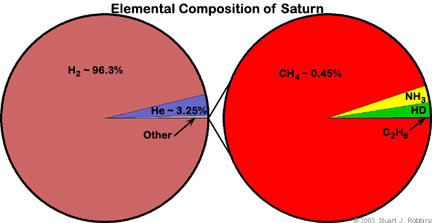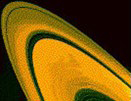Saturn
Saturn's Moons

Saturn is a gas giant. It's structure is very similar to Jupiter's.
The core is composed liquid rock. Next comes a layer of liquid hydrogen. It is
under such high pressure that the nature of the hydrogen changes, and is able
to conduct electricity like metal. This generates the planet's magnetic field.
The layer on top of this is ordinary liquid hydrogen. Next,
the hydrogen thins out into the gaseous atmosphere. It is composed of mainly
hydrogen and helium with trace amounts of methane, water, ammonia, and hydrogen
sulfide.
Interestingly, Saturn creates some of its own heat, but in
a much different way than Jupiter. Scientists believe that the hydrogen and helium
are slowly separating out, like vinegar and oil when left to sit. In Saturn's
case, the heavier helium is slowly making its way through the hydrogen, generating
heat (from friction) as it goes.
Saturn has something like Jupiter's Great Red Spot, but it
is a Great White Spot. Nothing is currently known about the phenomenon, but it
is probably similar to the Great Red Spot in the way it has formed. Besides this,
Saturn's outer atmosphere is not nearly as turbulent as Jupiter's. This is because,
being about two times farther away from the sun, it receives approximately 1/4
as much as energy from it. Less energy means that there is less to power atmospheric
phenomenon.
 Saturn
is basically one big atmosphere - as far as we know, there is no real surface
to the planet. Its composition is nearly all H2; the rest is approximately: Saturn
is basically one big atmosphere - as far as we know, there is no real surface
to the planet. Its composition is nearly all H2; the rest is approximately:
- H2: 96.3±2.4%
- He: 3.25±2.4%
- CH4: 0.45±0.2%
- NH3: 0.0125±0.075%
- HD: 0.011±0.0058%
- C2H6: 0.0007±0.00015%
Besides this, aerosols of ammonia ice, water ice, and ammonia
hydrosulfide exist in the atmosphere.
The temperature at 1 bar is approximately 134 K, and at 0.1
bar it is 84 K. The density at 1 bar is 190 g/m3. Below 30° latitude,
wind speeds range up to 400 m/s, and above that only 150 m/s. The scale height
of the Saturnian atmosphere is about 59.5 km.
Saturn has a few unique features:
-
First, it is the least dense of all the planets. If there
were a bathtub big enough to fit Saturn in, the planet would float. 
-
Second is Saturn's magnificent ring system. This system
has four sections. The farthest out, F, was discovered during the Voyager mission.
Moving towards Saturn, next is the A section, and this section makes up about
half the diameter of the entire system. Then comes the Cassini Division, between
A and B, which is the large gap visible in most photographs. Next is the B
ring, which has raised parts, caused by the planet's magnetism. These appear
as spokes. In-between B and C, there is a small division called Enck's Division.
The C ring is transparent. Farther in, there are very small ring particles
which are slowly spiraling in towards the planet.
The rings were probably formed relatively recently - several thousand years
ago - when two of Saturn's satellites crashed together. The ring systems of
the other gas giants probably formed the same way, only much earlier, which
is why they are mostly gone; most of their rings have fallen into their planet's
atmosphere. In about 100,000,000 years, Saturn's rings will probably be gone,
too. See the table below for data on its rings.
-
Another interesting property of Saturn is how it generates
heat. As seen in the table below, the average temperature of Saturn is approximately
130 K. However, due to the equation for thermal equilibrium (below), it should
only be about 80 K. This extra heat is generated due to its gas slowly separating.
Like an oily salad dressing, the gases in Saturn's atmosphere are very slowly
separating, with the lighter gas rising up and the heavier gas falling down.
As this happens, friction between the molecules heats the gas, accounting for
the extra heat.

- Pioneer 11 - 1 flyby in 1979
- Voyager 1 - 1 flyby in 1980
- Voyager 2 - 1 flyby in 1981
- Cassini - Saturn orbiter from 2004-Present
Saturn is named for the Roman Lord of the Rings. He is the
father of Jupiter. Saturn overthrew his evil father Uranus in order to rule.
Jupiter later overthrew Saturn because Saturn ate his children. He ate them because
he knew that one day one of them would take his power. Jupiter had managed to
get away.
|
|
|
|
|
|
|
| Saturn's Equator |
60,268
|
1.000
|
N/A
|
N/A
|
N/A
|
N/A
|
| D Ring |
> 66,900
|
> 1.11
|
|
|
|
|
| C Inner Edge |
74,658
|
1.239
|
0.05 - 0.35
|
0.12 - 0.30
|
0.4 - 5
|
|
| Titan Ringlet |
77,871
|
1.292
|
|
|
17
|
0.00026
|
| Maxwell Ringlet |
87,491
|
1.452
|
|
|
17
|
0.00034
|
| B Inner Edge |
91,975
|
1.526
|
0.4 - 2.5
|
0.4 - 0.6
|
20 - 100
|
|
| B Outer Edge |
117,507
|
1.950
|
|
|
|
|
| Cassini Division |
|
|
0.05 - 0.15
|
0.2 - 0.4
|
5 - 20
|
|
| A Inner Edge |
122,340
|
2.030
|
0.4 - 1.0
|
0.4 - 0.6
|
30 - 40
|
|
| Encke Gap |
133,589
|
2.216
|
|
|
|
|
| A Outer Edge |
136,775
|
2.267
|
|
|
|
|
| F Ring Center |
140,374
|
2.329
|
0.1
|
0.6
|
|
0.0026
|
| G Ring Center |
170,000
|
2.82
|
1.0x10-6
|
|
|
|
| E Inner Edge |
≈ 180,000
|
3
|
1.5x10-5
|
|
|
|
| E Outer Edge |
≈ 480,000
|
8
|
|
|
|
|
The rings are roughly 200 m (220 yd) thick except the A-ring
(≈50 m, 55 yd) and the C-ring (≈10 m, 11 yd).
|
| Perihelion (106 km) |
46.00 |
107.5 |
147.09 |
206.62 |
740.52 |
1352.55 |
2741.30 |
4444.45 |
| Mean Orbital Distance (106 km) |
57.91 |
108.2 |
149.60 |
227.92 |
778.57 |
1433.53 |
2872.46 |
4495.06 |
| Aphelion (106 km) |
69.82 |
108.9 |
152.10 |
249.23 |
816.62 |
1514.50 |
3003.62 |
4545.67 |
| Average Orbital Velocity (km/s) |
47.87 |
35 |
29.78 |
24.13 |
13.07 |
9.69 |
6.81 |
5.43 |
| Orbital Inclination (from
Earth's Orbit) |
7.00° |
3.4° |
0.0° |
1.850° |
1.304° |
2.485° |
0.772° |
1.769° |
| Orbital Eccentricity |
0.2056 |
0.007 |
0.0167 |
0.0935 |
0.0489 |
0.0565 |
0.0457 |
0.0113 |
| Equatorial Radius (km) |
2439.7 |
6051.8 |
6378.1 |
3397 |
71,492 |
60,268 |
25,559 |
24,764 |
| Polar Radius (km) |
2439.7 |
6051.8 |
6,356.8 |
3375 |
66,854 |
54,364 |
24,973 |
24,341 |
| Volume (1010 km3) |
6.083 |
92.843 |
108.321 |
16.318 |
143,128 |
82,713 |
6833 |
6254 |
| Ellipticity (Variation from
Sphere) |
0.0000 |
0.000 |
0.00335 |
0.00648 |
0.06487 |
0.09796 |
0.02293 |
0.01708 |
| Axial Tilt (from Earth's geographic
North) |
0.01° |
177.4° |
23.45° |
25.19° |
3.13° |
26.73° |
97.77° |
28.32° |
| Mass (1024 kg) |
0.3302 |
4.87 |
5.9736 |
0.64185 |
1898.6 |
568.46 |
86.832 |
102.43 |
| Density (water=1) |
5.427 |
5.243 |
5.515 |
3.933 |
1.326 |
0.687 |
1.27 |
1.638 |
| Escape Velocity (km/s) |
4.3 |
10.36 |
11.19 |
5.03 |
59.5 |
35.5 |
21.3 |
23.5 |
| Gravity (m/s2) |
3.70 |
8.802 |
9.78 |
3.716 |
23.1 |
9 |
8.7 |
11 |
| Surface Pressure (bars) |
≈ 10-15 |
92 |
1.014 |
0.000636 |
N/A |
N/A |
N/A |
N/A |
| Total Mass of Atmosphere (kg) |
< 1000 |
4.8x1020 |
5.1x1018 |
2.5x1016 |
N/A |
N/A |
N/A |
N/A |
| Sidereal Rotation Period (hours) |
1407.6 |
-5832.5 |
23.9345 |
24.6229 |
9.9250 |
10.656 |
-17.24 |
16.11 |
| Length of Day (hours) |
4222.6 |
2802 |
24 |
24.6597 |
9.9259 |
10.656 |
17.24 |
16.11 |
| Tropical Orbital Period (days) |
87.968 |
224.7 |
365.256 |
686.980 |
4330.595 |
10,746.94 |
30,588.740 |
59,799.9 |
| Bond
Albedo |
0.119 |
0.750 |
0.306 |
0.250 |
0.343 |
0.342 |
0.300 |
0.290 |
| Visual
Geometric Albedo |
0.106 |
0.65 |
0.367 |
0.150 |
0.52 |
0.47 |
0.51 |
0.41 |
| Visual
Magnitude |
-0.42 |
-4.40 |
-3.86 |
-1.52 |
-9.40 |
-8.88 |
-7.19 |
-6.87 |
| Solar
Irradiance (W/m2) |
9126.6 |
2613.9 |
1367.6 |
589.2 |
50.50 |
14.90 |
3.71 |
1.51 |
| Black-Body
Temperature (K) |
442.5 |
231.7 |
254.3 |
210.1 |
110.0 |
81.1 |
58.2 |
46.6 |
| Average
Surface Temperature (Celsius) |
167° |
464° |
15° |
-65° |
-110° |
-140° |
-195° |
-200° |
| Number
of Moons |
|
|
|
|
|
|
|
|
| Rings? |
No |
No |
No |
No |
Yes |
Yes |
Yes |
Yes |
| Global
Magnetic Field Strength (Gs) / Tilt |
0.0033 / 169° |
- / - |
0.3076 / 11.4° |
- / - |
4.28 / 9.6° |
0.210 / <1° |
0.228 / 58.6° |
0.142 / 46.9° |
| Discoverer |
Unknown |
Unknown |
Unknown |
Unknown |
Unknown |
Unknown |
William Herschel |
Johann Gottfried Galle |
| Discovery
Date |
Prehistory |
Prehistory |
Prehistory |
Prehistory |
Prehistory |
Prehistory |
March 13, 1781 |
September 23, 1846 |

|



